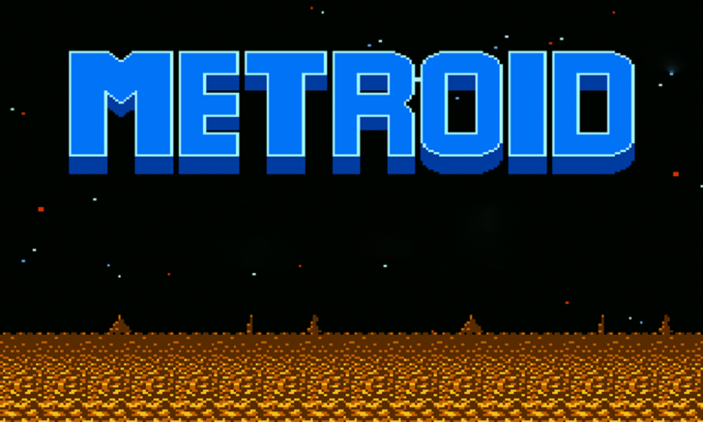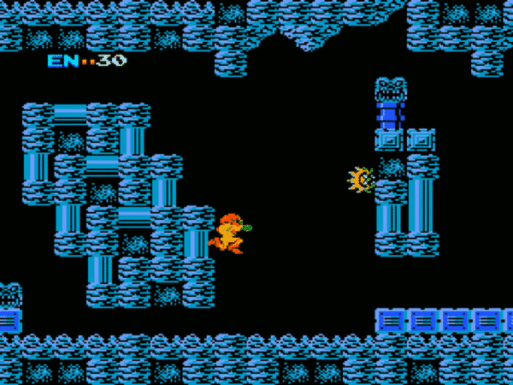Even if in space someone could hear you scream, that just wouldn’t be Samus’ style. In an industry that more often than not sates the senses, the NES’ Metroid slipped quietly away from its less subdued Nintendo brethren, resisting the urge to add its voice to the growing 8-bit cacophony and instead building a 30-year franchise by realizing that one of the most powerful ways to feel something is to hear nothing.
The saying goes that silence is golden, but in 1986 games like Super Mario Bros. and The Legend of Zelda possessed hummable melodies that fit perfectly with their whimsy and sense of mythical adventure, catchy tunes that to this day elicit near-Pavlovian responses from players everywhere. Game sounds were no longer just a set of bleeps and bloops designed as contextual feedback for what was happening on screen, but they had also become actual music, scores that complimented the gameplay and even helped with brand recognition. People who have never stomped a single goomba still recognize the Mushroom Kingdom’s main theme, and the soundtracks to Link’s many iterations have toured the world in symphony to resounding success. A marketer’s dream, one that naturally had an effect on other game makers, who were inspired to create ad-like jingles for their own products that would be just as memorable.
Yet despite numerous chiptune masterpieces, few games can point to their soundtrack as one of the reasons for their longevity like Metroid can. Though many may look back fondly on what has now been acknowledged as a classic whose influence can be felt in any titles offering open exploration, at the time Samus’ first adventure was just another video game. A fun one, sure, but there was plenty of entertainment in the NES era. The platforming in Metroid couldn’t match the precision jumps of Mario, and Link already had his hands full in the backtracking adventure line. The necessity of the cartography involved, though enjoyable when sitting next to some friend suckered into holding a pencil and graph paper instead of a controller, could get tedious and disrupt the flow when done solo. It was the beginning of a genre that wouldn’t be perfected until its SNES sequel, and though the ending had a twist that blew our 8 year-old male minds, when the furor died out the schoolyard chatter quickly moved on to other topics.
Still, something lingered, the echo of footsteps running through dark corridors and the eerie, the distant squeaks of unknown lifeforms. While on the planetary surface Metroid just didn’t seem to call attention to itself (unlike the endlessly explosive machine-gunning of Commando before it or the fantastical sword-slashing of Wizards & Warriors soon to follow), it is precisely for this reason that it stood out and attached itself to gamers’ minds long after the mission was over. What Metroid had that other games to that point lacked was atmosphere, a vibe, and much of it was built around an aural philosophy that less equals more.
Much like with Ridley Scott’s sci-fi horror masterpiece Alien, much of which served as inspiration for the developers of Metroid, sound designer Hirokazu Tanaka (credited as “Hip” Tanaka) recognized that achieving a feeling of total abandonment and desolation meant mixing into his amelodic score a symphony of stillness, filling the void with more void and driving home the point that Samus, and thus the player, is all alone. Zebes was a departure from the upbeat environment Nintendo (and most of the industry) usually fostered, leading to a tension, as any peep was both welcome company and cause for dread. The constant anticipation of danger suspended only by the brief oases of relief upon hearing the familiar tones signifying a power up conveyed perfectly the castaway mentality and gave Metroid an overtone akin to something not unlike survival horror.
As an alien herself on an alien world, delving deeper into the labyrithine caverns only cut Samus off more from the known and forced players into an uneasy state where threats could arise from anywhere. Paying attention to one’s surroundings is necessary to navigating hostility from both natural and unnatural sources, and so sound cues in Metroid are vital to subsistence in a world that carries on regardless of who interrupts it. In an interview with Gamasutra, Tanaka describes how he wanted the music to give the impression that players “were encountering a living creature” that perfectly melded with the gameplay, creating something “without any distinctions between music and sound effects.” As if the space pirates and their deranged experiments weren’t enough, the whole planet seems an imposing figure, with bubbling lava, crumbling rock, and the strange chirps of its lethal denizens.
Though the excited pace of Brinstar’s theme is stirring, only in the end, after the gurgling low tones accompanying the battle with the notorious Mother Brain have been heard and Samus has escaped the destruction of the Pirate’s lair, do players finally hear the gratifying music of a hero. Safety has returned to the galaxy and to gaming in general, and all is right with the universe once again, the haunting notes of the title screen left in the distant past.
They would not easily be forgotten, however, and largely thanks to the otherworldly ambience the sound design helped create, neither would Metroid. Though many of its sequels would surpass it in quality and reputation, none would have been possible without Samus’ first step into a quieter world. The distinct atmosphere the franchise is known for continues to stand out among its peers, and thirty years later that silence still speaks volumes. I can’t wait to hear it again.




